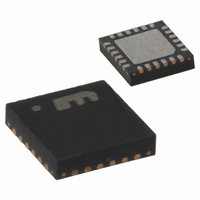MICRF405YML TR Micrel Inc, MICRF405YML TR Datasheet - Page 16

MICRF405YML TR
Manufacturer Part Number
MICRF405YML TR
Description
868-915 MHz ISM Band Transmitter
Manufacturer
Micrel Inc
Datasheet
1.MICRF405YML_TR.pdf
(46 pages)
Specifications of MICRF405YML TR
Frequency
290MHz ~ 980MHz
Applications
ISM
Modulation Or Protocol
ASK, FSK
Data Rate - Maximum
200 kbps
Power - Output
10dBm
Current - Transmitting
18mA
Data Interface
PCB, Surface Mount
Antenna Connector
PCB, Surface Mount
Voltage - Supply
2.2 V ~ 3.6 V
Operating Temperature
-40°C ~ 125°C
Package / Case
24-MLF®, QFN
Operating Temperature (min)
-40C
Operating Temperature (max)
125C
Operating Temperature Classification
Automotive
Product Depth (mm)
4mm
Product Length (mm)
4mm
Operating Supply Voltage (typ)
2.5/3.3V
Operating Supply Voltage (max)
3.6V
Lead Free Status / RoHS Status
Lead free / RoHS Compliant
Features
-
Memory Size
-
Lead Free Status / Rohs Status
Compliant
Other names
576-1965-2
MICRF405YMLTR
MICRF405YMLTR
MICRF405YMLTR
MICRF405YMLTR
April 2006
The sequence of a typically packet transfer is shown
in Figure 7.
Micrel
1. Set the 405 in transmit mode with the correct
2. Pull SEN low, and address the TX buffer.
3. Write the frame length into the data buffer. On
4. When the last bit of the last SyncID byte is
5. In this step, all user data is received in the 405
settings by writing in the TX control word.
Once SEN is pulled high, the internal load will
activate the new settings. The 405 will now
start the PLL and turn on the PA (if
PA_LDc_en is set)
Address=29+R/W, RW=”0”.
the 8
bit, the modulation will start. If MOD_LDc_en is
not set, check that lock detect (LD) is high after
PA is turned on before writing last bit (or the
complete byte 3). If MOD_LDc_en=1, finish
steps 2 and 3 immediately after step 1. The
MICRF405 will now wait until the transmitter is
ready (PLL tuned in, PA on and LD high)
before starting to modulate. In either case, the
packet engine will start to transmit the desired
preamble
modulation starts.
being sent, the RDY signal is high. After the
falling edge of RDY, the packet engine is
sending the frame length, and the buffer is
then ready for refill. The time between 3 and 4
will vary depending, upon the bit rate and
desired number of bytes in the preamble and
SyncID field. The first RDY pulse will, however,
notify the user when to enter the 1
payload. Step four is repeated for all the bytes
in the payload, meaning [frame length –
number of CRC bytes] times. It is important
that the buffer is refilled after the falling edge of
RDY and before the next falling edge of RDY.
and it transmits the last part of the packet. This
th
falling edge of SCK, clocking in the last
and
SyncID
bytes
st
byte of the
once
the
16
6. The frame is now completely transmitted. If
means that the SEN now can be pulled high at
any time, closing the
PA_LDc_en=1 and load_en=1, it is then
necessary to leave SEN low until the end of
packet. This is because raising SEN will
generate a load pulse, and this, in turn, causes
the PA_LDc function to turn off the PA for a
short period of time. The RDY signal will be
high when the last bit of the payload is being
sent, but there is now no need to refill the
buffer. Also, if CRC is enabled, then RDY will
be high during the last bit of each of the CRC
bytes being sent. Because of an internal
sampling the actual RF output lags 1 bit
period, which means the modulation will stop
one bit period after the last RDY pulse.
PA_FEc_en=1, the PA will be automatically
turned off immediately after last bit in packet is
transmitted. The PLL will, however, remain
running. (This state is equal to MODE[1:0]=3
(TX),
PA_FEc_en=0 the PA will remain on until it is
turned off by the MODE or PA bits. In step 6,
the buffer is ready for a new packet. Any 8bits
entered into the buffer in this sections is
though of as a new frame length, refer back to
Section 3. This, assuming the MICRF405
remains in TX (MODE[1:0]=3). In this case,
and when PA_FEc_en=1, the PA will be turned
on once the 8
recommended to use the MOD_LDc function in
this case as it will delay the modulation until
the PLL has stabilized after the PA is turned
on. If not the start of the modulation will be
distorted and may interfere the settling of the
PLL due to PA turn on (please see chapter
Lock Detect).
PA_LDc_en=0
th
bit is clocked in. It is
and
write session. If
PA[2:0]=0.)
MICRF405
(408) 955-1690
M9999-041906
If











